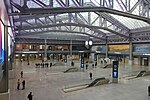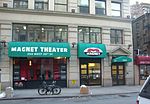New York City Guitar School
New York City Guitar School is a teaching and performance institution with locations in Manhattan, Queens, Brooklyn, and Westchester County. Founded in 2004, by guitarist and teacher Dan Emery, the school began as a single room in the Recording and Rehearsal Arts Building, on West 30th Street, in Manhattan's Chelsea district. The school's five studios currently serve a population of over 2500 students, offering students of multiple skill levels private lessons and small group classes. Additionally, New York City Guitar School offers tutelage in other instruments, Suzuki method courses for young children, and band programs for kids, teens, and adults. Jen Elliott, who was involved with the school from its 2004 inception, became a co-owner of the company in 2012. She and Dan Emery act as the school's co-directors and program coordinators.
Excerpt from the Wikipedia article New York City Guitar School (License: CC BY-SA 3.0, Authors).New York City Guitar School
West 30th Street, New York Manhattan
Geographical coordinates (GPS) Address Nearby Places Show on map
Geographical coordinates (GPS)
| Latitude | Longitude |
|---|---|
| N 40.749436 ° | E -73.994194 ° |
Address
West 30th Street 251
10001 New York, Manhattan
New York, United States
Open on Google Maps






